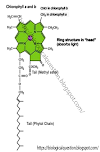Angiosperms (enclosed seed plants)
Angiosperms are the flowering plants. Their seeds are enclosed by fruits. The leaves bearing ovules are folded and joined at the margins to form ovaries. The ovary after fertilization is changed into fruit. This is exceptionally a large and successful group of plants which is divided into Dicots and Monocots. They have common characters, like, vascular tissues, differentiated plant body, flowers, fruits, and seeds.
Life Cycle of a Flowering Plant
There is an alternation of generations in the flowering plants. The sporophyte, a diploid dominant generation alternates with haploid inconspicuous gametophytic generation.
The main plant body is diploid sporophyte which produces haploid spores. Flower is the reproductive structure which bears anthers and carpels as male and female reproductive parts respectively. The anther when fully developed contains 2 to 4 elongated sacs called pollen sacs. The pollen sacs contain pollen grains.
When the anther is developing, mitotic divisions produces microspore mother cells. Following meiosis in a diploid mother cell, four haploid microspores are produced. A microspore divides mitotically into a two celled, pollen grain. A tough wall develops around the pollen grain, which protects the contents of the pollen grain from drying out. Cells on the surface of the stigma secrete a sticky nutrient fluid containing sugar and other substances.
After pollination the pollen grains germinate on the stigma. Each pollen grain produces the tissues of the a slender, thin walled pollen tube. The pollen tube grows down, through the tissue of the stigma, style and ovary until it reaches the ovule.
As the pollen tube develops, the two nuclei of the pollen nuclei are called generative nucleus and the pollen tube nucleus. Generative nucleus divides again to form two somewhat elongated sperms. The tube nucleus is located near the tip of the pollen tube with two sperms following behind. The pollen tube, containing tube nucleus and the two sperms (male gametes), is the male gametophyte.
The ovule is an egg shaped structure attached by a stalk, to the inside of the ovary. Depending upon the species of the plant involved, an ovary may have one, two, several or even thousands of ovules. The ovule has an opening called micropyle. Megaspore mother cell of the ovule undergoes meiosis to produce four haploid cells. Only one of these cells survives. The surviving cell is called the megaspore which divides by mitosis three times to produce eight haploid nuclei. This structure is called embryo sac. Wall formation takes place and these nuclei are converted into cells. The cells of embryo sac are: antipodal cells, polar nuclei, synergids and egg. The embryo sac having these cells are called female gametophyte.
Antipodal cells are three in number and are present at the opposite end of the micropyle, and have no function and sooner or later get disorganized. Synergids are two in number at the micropyler end. These help in fertilization by guiding the pollen tube and as soon as their function is over these get disorganized. Polar nuclei are two in number, placed in the centre. By the time egg has been fertilized, the two polar nuclei have combined to form a single fusion nucleus.
Egg is one in number and is present between the two synergids. Soon after the tip of the pollen tube enters the embryo sac, the end of the tube ruptures and releases the two sperms into the embryo sac. The first sperm fuses with the egg to form a zygote.
The zygote develops into an embryonic plant within the ovule. The second sperm deposited in the embryo sac by the pollen tube moves to the centre and unites with the fusion nucleus. Union of one sperm with the egg and, the second sperm with the fusion nucleus is called double fertilization. It only occurs in the flowering plants.
Formation of seeds and fruits :
Zygote develops into an embryonic plant within the ovule. After fertilization fusion nucleus develops into an endosperm. It is triploid, i.e., consists of three sets of haploid number of chromosomes, as two polar nuclei, and one sperm nucleus fuses to form it. Endosperm divides, enlarges and is used as store of food for the young embryo.
Life Cycle of Angiosperms
After double fertilization the formation of embryo and endosperm tissue takes place. As a result the ovule increases in size. The embryo consists of: (i) one or two cotyledons (ii) epicotyl (iii) hypocotyl. Both epicotyl and hypocotyl are the parts of the rod like axis attached to the cotyledons. In some plants cotyledons digest and absorb endosperm as the ovule is maturing into seed. The ovary wall enlarges and ripens to become the fruit.
Thank you reading the article.



.png)


0 Comments